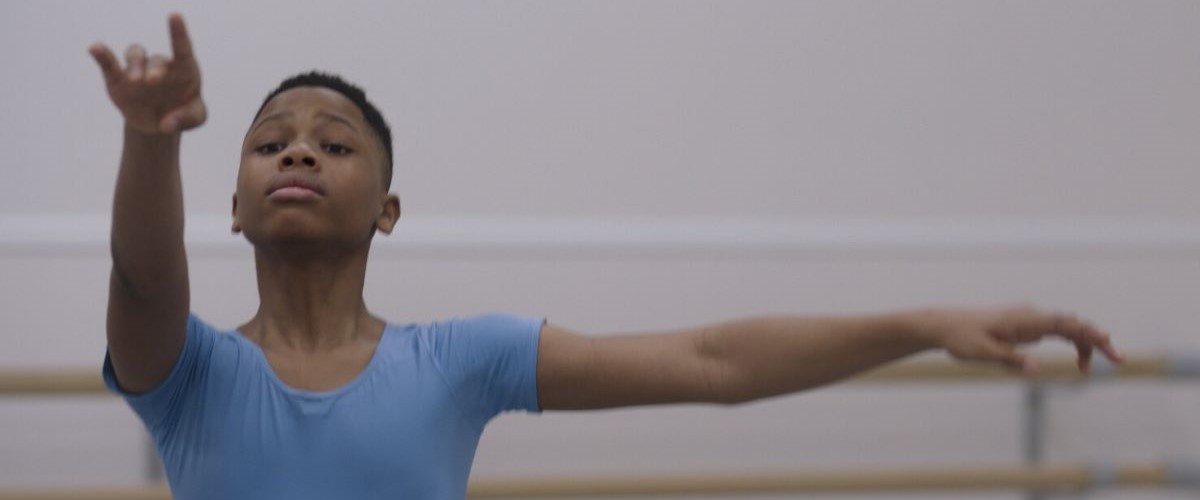It’s recess at a small school in Nigeria and the boys are kicking around an empty water bottle in an improvised game of soccer. Except for one. Anthony Madu on the far side of the playground, is performing a private ballet. One of his classmates asks, “Why is he dancing like a girl?”
Anthony is dancing because that is who he is. When he is not dancing, his body is shy, uncertain. When he dances, he is sure, elegant, graceful. “Madu” is a documentary about what happened when a brief 2020 video of Anthony dancing barefoot in the rain went viral, leading to an invitation to study in a seven-year program at an elite British ballet academy. As the film begins, he is packing and saying his farewells. He receives his passport, where he is described as a “child student.” His mother is proud, happy for him, but painfully aware of how much she will miss him. We see him silhouetted against the train window, an unfamiliar landscape outside. When he arrives, he calls home and like all mothers, her first question is “Have you eaten?”
In their call a few weeks later, she says Anthony is adopting a British accent and his brother says, “You’re speaking like a white person.” We see the poignance of Anthony’s missing his family but feeling that the shared dedication to dance is a different kind of home, equally precious. “Home is a place where you feel like you belong,” he says, meaning the world of dance, but then he says home is also where your family is.
We might have expected that Anthony might feel isolated or even bullied for being from another country and culture, but his classmates are all friendly and inclusive. Some of the film’s sweetest moments are watching Anthony completely comfortable as he is laughing with his friends or hugging them goodbye as they leave for summer break. Some of the most touching are when we see his parents watching his performance as one of the stars of the end of school year production, via FaceTime, in Nigeria.
The entering class is told they are the select few of over 500 who applied. But this is not like the many other dance films about demanding teachers. The presence of the documentary cameras may be a factor, but the kindness, sensitivity, and compassion of everyone Anthony meets is so pervasive that it is clearly the culture of the community around him. A teacher tells the students that a warmth in the muscles during practice is good, but if it ever burns, they should stop. And when a serious health issue arises, the school and the doctors are sympathetic and supportive.
The style of the documentary is “fly on the wall.” Filmmakers Matthew Ogens and Joel Kachi Benson include occasional interviews with Anthony and his parents but no talking head experts. Cinematography by Charlie Goodger and Motheo Moeng is intimate and lyrical, with contemplative music that contrasts with the classical pieces accompanying the dance lessons and performance. An opening scene shows us Anthony dancing near a fire, his movements in the flickering light showing the fiery spirit that impels him. Near the end, he is on the beach, wading into endless water stretching all the way to the horizon, indicating the larger, more centered sense of himself and his passion for ballet made possible by access to teachers and other dancers, and a sense of possibility. But, as with the boys at the center of documentaries like “Hoop Dreams” and “The Wolfpack,” the focus on those who are too young to have a nuanced understanding of what is happening to and around them can make us feel both unsatisfyingly removed and uncomfortably intrusive. Maybe the only solution is to require any documentary about those who are underage to be locked away and then brought out again when the children are old enough to watch it and make up their minds about whether they are willing to have it seen.
Anthony’s eloquence is in his movement. A telling moment is his assignment to create a dance performance. Even to an untrained eye, his extraordinary gifts are unmistakable. His grace, balance, and control are exceptional, and his leaps are breathtaking. The teachers who are evaluating him are warmly encouraging, complimenting his love of movement. They gently ask whether he had a story in mind. When he says no, they suggest he try to imagine a narrative. Given the complexity and near-fairy tale improbability of his real-life story, it is not surprising that Anthony is comfortable taking a break from plot to revel in the pure abstraction of movement. With this documentary, we can appreciate his story, and his relevé and pirouette.
On Disney+ now.




















